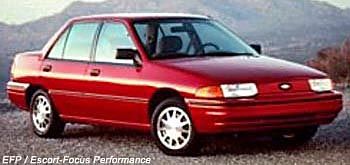 |  |  |  |  |  |
 |  |  |  |  |  |
|  | |  | |
|
| In hard acceleration, either engine causes the automatic transmission to jolt between gears. With
automatic, there's just not enough low-end power for quick getaways. Acceleration to 60 mph took a leisurely 12.5 seconds. Though more powerful, the GT's engine gets lazy below 3500 rpm; but it runs smoother than the 1.9-liter. Both engines vibrate at idle, and are noisy while cruising. Gas mileage is great. An early automatic LX averaged 25.9 mpg. A later edition did better yet, averaging 26.8 mpg even while commuting.
Stable and well-controlled at highway speeds, the Escort's
suspension is surprisingly absorbent on harsher pavement. A GT handles crisply, courtesy of its sport suspension and 15-inch tires. The same cannot be said of Pony and LX hatchbacks, whose 13-inch rubber easily loses grip in brisk cornering. Standard 4-wheel disc brakes on the GT bring the Escort to a swift, sure stop. Wind and road noise are noticeable, especially at highway speeds.
Visibility is good from the Escort's airy cabin. Head room isn't bad for a subcompact, unless it has
the optional sunroof. Leg room is adequate, but three in back is a squeeze. The cargo area of hatchbacks and wagons is quite narrow between wheelwells, but wider at the rear. Controls are logically positioned, simply marked, operating with smooth precision that belies the car's modest roots. |
|
|  | |  | |
|
| Two engines were available in 1991 Escorts: a carryover 1.9-liter, rated at 88 horsepower; or in the GT, a Mazda dual-overhead-cam 1.8-liter (four valves per cylinder) that made 127 horses. Transmissions were supplied by Mazda: either a 5-speed stick or an optional 4-speed automatic. For 1996, the 1.9-liter engine gained platinum-tipped spark plugs. Ford issued an
all-new Escort as an early '97 model. |
|
| |
| ohc I4 | 1.9 / 114 | 88 | 108 | 5-speed manual: 31/38
4-speed automatic: 26/34 | 5-speed manual: --
4-speed automatic: 25.9
| dohc I4 | 1.8 / 109 | 127 | 114 | 5-speed manual: 25/31
4-speed automatic: 23/29 | |
| |
|
| Vehicle Problems Blower motor: Squeaking or chirping blower motors are the result of defective brush holders. (1993-94)
Brake noise: Wear spots and ridges on the front brake caliper sleeves cause a knocking noise when gently applying the brakes. (1991-96)
Brakes: There is a redesigned brake master cylinder and brake booster available that provides better pedal feel and travel. (1993-95)
Engine knock: Carbon build-up on the pistons causes a knocking noise. Sometimes solved by cleaning the carbon from the pistons using carburetor cleaner, often pistons must be replaced with redesigned ones. (1991-93)
Fuel pump: Under general campaign number 94B55, Ford
will install a fused jumper harness in the fuel pump electrical circuit to prevent erratic fuel gauge readings, stalling, or wiring damage. (1991-94)
Hard starting: If the engine does not start or cranks for a long time then stalls, the idle air control valve may be sticking. (1995-96) It can be taken apart, cleaned, and lubed.
Horn: Sometimes the horn will not work due to a poor ground circuit in the steering column. (1995-96)
Transmission noise: If a whine comes from the transmission during coast-down, it is probably because the idler gear teeth were not machined properly. (1995-96)
Vehicle noise: A grinding noise while turning is most likely due to dirt accumulating in the top strut mount bushing. (1991-92)
Valve Seats: Some of the 1.9L engines had a habit of losing valve seats in the cylinder head. We have seen engines go over 100,000 miles before having this problem. The early engines never seem to have them come loose. It seems to be mostly 1993 to 1995 engines for some unknown reason. If could be due to a manufacturing problem, materials, or detonation.
Tie Rod Ends: The tie rod ends on these cars seem to wear out too frequently, sometimes in as little as 40,000 miles. They are sized too small and don't have any way to add grease. |
|
| NHTSA Recalls 1991: Interference may occur between bolt that secures fuel line shield to lower dash and gas pedal, causing pedal to stick wide
open.
1991: Pins securing ignition lock can separate or move out of position; cylinder may disengage, causing steering column to lock
up.
1991-92: On some cars, fatigue crack can develop in solder joint between fuel return tube and fuel pump sending unit; fuel vapor
could escape when tank is full, and small amount may leak.
1991-93: On small number of front suspension units made by Dana Corp., the offset-toe adjusting pin may fracture under
certain conditions, resulting in loss of control.
1993:
Driver's seat in some cars may not engage fully in its track in positions near midpoint; could move in event of crash.
1994-95: On a few cars, driver-side airbag may deploy improperly and expel hot gases.
1995: Cracks can develop in plastic fuel tank, resulting in leakage.
1995: Two bolts that attach passenger-side airbag may be missing; in frontal impact, the airbag could fail to restrain the passenger. |
|
| Click here to go to top | |
|
| Home Escort Parts Focus Parts Tech & Info Ordering Legal Info Contact Us Links | |



